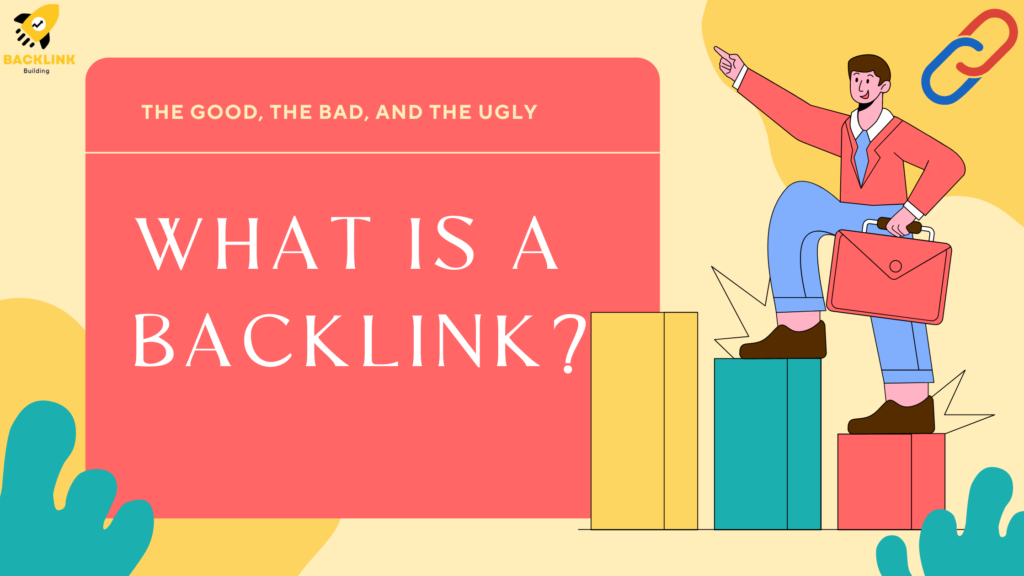
In the SEO world, backlinks are both a blessing and a curse. On the one hand, they’re an important ranking factor that can help boost your website up the search engine results pages (SERPs). On the other hand, if you don’t have a good mix of high-quality backlinks, you could end up being penalized by Google. So, what is a backlink? How can you tell if a backlink is good or bad? And what’s the best way to get them? Keep reading to find out.
What Is A Backlink?
A backlink is simply a link from one website to another. Backlinks are sometimes called “inbound links” or “incoming links.” But what exactly do backlinks have to do with SEO? Search engines like Google use backlinks to gauge a website’s quality and relevancy. In other words, if websites with high domain authority link to your website, that’s a good sign that your site is also high-quality and relevant. On the other hand, if you have a bunch of low-quality backlinks from spammy sites, that will not look good in Google’s eyes.
Why Are Backlinks Important?
Backlinks are important because they help search engines like Google understand the value, trust, and relevance of your website. Here’s a simple breakdown of why backlinks matter:
1. They Help Improve Search Rankings
When trusted websites link to your page, it is a signal to search engines that your content is valuable. The more quality backlinks you have, the higher your chances of ranking on the first page of Google.
2. They Build Website Authority
Backlinks from top sites show that your site is trustworthy. Over time, this builds your domain’s authority in your niche or industry, which helps you compete for tough keywords.
3. They Drive Referral Traffic
People who click on backlinks from other websites land on your site. If the backlink is placed in a relevant article, it can bring in targeted visitors who are more likely to engage with your content or buy your product.
4. They Help Search Engines Discover Your Content
Search engine bots use backlinks to find new content on the internet. If your page is linked from another page that Google already knows, it can help your content get indexed faster.
5. They Boost Brand Visibility and Credibility
When users see your site mentioned and linked on popular blogs, news websites, or industry forums, it builds brand awareness and trust—even before they visit your site.
6. They’re Key for Long-Term SEO Strategy
Good backlinks do not just give you a one-time boost. They keep bringing value over time, helping your site stay relevant and competitive in search results for months or even years.
Types Of Backlinks
Now that we know what backlinks are and why they’re essential, let’s look at some of the different backlinks out there.
1. Dofollow Backlinks
These pass SEO value (link juice) and help with ranking.
Example: A blog links to your site with a regular hyperlink.
2. Nofollow Backlinks
These tell search engines not to pass link juice, but they still bring traffic.
Example: Links in YouTube descriptions or blog comments.
3. Sponsored or Paid Backlinks
Paid links for promotions, must be marked as sponsored to follow Google’s rules.
Example: Paying a blogger to link to your product.
4. Image Backlinks
Happen when someone uses your image and links back to your site for credit.
Example: Your infographic is used in a blog post with a backlink.
5. Internal Links
Links from one page to another within the same website.
Helps users and search engines navigate your site.
Example: Your homepage links to your blog page.
6. External Links
Links from your site to other websites.
They show that your content is well-researched and connected.
Example: Linking to a trusted stat from another blog.
7. Anchor Text Links
Links where the text is clickable, usually includes a keyword.
Example: Click here to learn about SEO tools (anchor = “SEO tools”).
8. Raw URL Links
Just the plain link without anchor text or formatting.
Example: https://example.com
How to Get High-Quality Backlinks

Getting backlinks is not just about quantity — it’s about quality. Here’s how to earn links that actually help your SEO:
1. Create Valuable, Link-Worthy Content
Great content attracts links naturally. Focus on:
- In-depth guides
- Case studies
- Original research
- Infographics
- Tools or templates
💡 If your content solves a real problem, people will link to it.
2. Use Guest Posting Strategically
Write helpful articles for reputable blogs in your niche.
- Include a contextual backlink (naturally placed)
- Avoid spammy or unrelated sites
🎯 Target websites with good traffic and authority.
3. Leverage Digital PR & Outreach
Reach out to journalists, bloggers, and influencers with valuable pitches.
- Use platforms like HARO, SourceBottle, or Qwoted
- Share expert quotes or unique insights
📢 Good stories = good backlinks.
4. Build Broken Link Opportunities
Use broken link building to your advantage—find broken links on relevant websites and suggest your content as a valuable replacement.
- Use tools like Ahrefs or Check My Links
- Keep your pitch short and helpful
🔗 You help them fix a problem — they reward you with a link.
5. Use Skyscraper Technique
Find top-performing content in your niche, create a better version, and reach out to sites linking to the original.
🏗️ Outdo the best, then promote it.
6. Get Listed in Resource Pages
Many sites maintain pages like “Top Tools” or “Useful Resources.”
- Search Google with terms like:
- “Top [your niche] tools”
- “Best resources for [your topic]”
- Reach out and suggest your content or tool
🧰 Perfect for SaaS, tools, guides, and case studies.
7. Earn Links Through Partnerships
Collaborate with industry partners, co-host webinars, or co-author content.
- Each collaboration = a backlink opportunity
🤝 Networking helps SEO too.
Common Backlink Mistakes to Avoid
1. Buying Links Without Proper Tags
Paying for links is risky if not done transparently.
- Mistake: Not marking them as sponsored
- Result: Google penalties for manipulative link building
2. Focusing on Quantity Over Quality
Chasing hundreds of low-value backlinks won’t help.
- Mistake: Building links from spammy or unrelated sites
- Result: Weak SEO impact, or worse, a ranking drop
3. Ignoring Relevance
Relevance is key for SEO value.
- Mistake: Getting backlinks from sites outside your niche
- Result: Confuses search engines and weakens your authority
4. Over-Optimizing Anchor Text
Repeating exact-match keywords looks unnatural.
- Mistake: Using “best SEO tool” as anchor every time
- Result: Google flags it as manipulation (over-optimization)
5. Not Checking Site Authority or Traffic
Not all sites are equal — some links carry no weight.
- Mistake: Getting links from sites with no real audience or traffic
- Result: Wasted effort with no SEO return
6. Relying Too Much on One Tactic
A natural backlink profile is diverse.
- Mistake: Only doing guest posts or only using directories
- Result: Your profile looks unnatural and can be devalued
7. Ignoring Toxic or Spammy Links
Bad links can hurt more than help.
- Mistake: Not disavowing harmful backlinks
- Result: Risk of Google penalties or ranking drops
8. Building Sitewide Footer or Sidebar Links
Overused and often considered manipulative.
- Mistake: Getting links in footers across hundreds of pages
- Result: Low SEO value and can trigger spam filters
9. Skipping Competitor Analysis
You miss backlink opportunities others are using.
- Mistake: Not checking where competitors are getting links
Result: You fall behind in search visibility
Best Tools to Check Backlinks
1. Ahrefs
One of the most powerful backlink checkers available.
- Shows new, lost, and broken backlinks
- Gives detailed metrics like Domain Rating (DR), anchor text, and referring domains
- Excellent for competitor analysis
💼 Best for: SEO professionals, agencies, and link audits
2. SEMrush
Comprehensive SEO suite with a strong backlink analytics tool.
- Tracks your backlinks over time
- Compares your link profile with competitors
- Identifies toxic links
📊 Best for: Full-service SEO tracking and reporting
3. Moz Link Explorer
User-friendly tool with useful backlink data.
- Offers a simple overview of link metrics
- Uses Domain Authority (DA) and Page Authority (PA)
- Helpful for small businesses and beginners
🔍 Best for: Beginners or Moz users
4. Majestic SEO
Focuses heavily on link quality and flow metrics.
- Trust Flow and Citation Flow for backlink quality
- Great historical link data
- Useful visualizations
🔗 Best for: Deep link profile analysis
5. Google Search Console (Free)
Official tool from Google that shows backlinks pointing to your site.
- Great for verifying live links
- Not as detailed, but reliable
- Helps with identifying harmful backlinks for disavow
Best for: Basic backlink checks and Google-based data
6. Ubersuggest
Affordable and beginner-friendly tool by Neil Patel.
- Backlink overview with domain and page-level data
- Shows referring domains, link types, and anchor text
💡 Best for: Small teams or solo marketers
7. Serpstat
All-in-one SEO platform with backlink tracking.
- Offers historical data and competitor comparison
- Provides backlink growth charts and link types
📈 Best for: Budget-conscious users needing full SEO features
Conclusion
Backlinks are an important ranking factor for SEO, but ensuring that you’re only pursuing high-quality backlinks from reputable websites is essential. There are several different types of backlinks, including dofollow/nofollow, internal/external, and anchor text/image/raw URL. All of which can be beneficial depending on the context in which they’re used. So now that you know more about backlinks, it’s time to start pursuing them!


